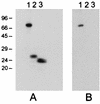Biological properties and cell tropism of Chp2, a bacteriophage of the obligate intracellular bacterium Chlamydophila abortus
- PMID: 11976304
- PMCID: PMC135034
- DOI: 10.1128/JB.184.10.2748-2754.2002
Biological properties and cell tropism of Chp2, a bacteriophage of the obligate intracellular bacterium Chlamydophila abortus
Abstract
A number of bacteriophages belonging to the Microviridae have been described infecting chlamydiae. Phylogenetic studies divide the Chlamydiaceae into two distinct genera, Chlamydia and Chlamydophila, containing three and six different species, respectively. In this work we investigated the biological properties and host range of the recently described bacteriophage Chp2 that was originally discovered in Chlamydophila abortus. The obligate intracellular development cycle of chlamydiae has precluded the development of quantitative approaches to assay bacteriophage infectivity. Thus, we prepared hybridomas secreting monoclonal antibodies (monoclonal antibodies 40 and 55) that were specific for Chp2. We demonstrated that Chp2 binds both C. abortus elementary bodies and reticulate bodies in an enzyme-linked immunosorbent assay. Monoclonal antibodies 40 and 55 also detected bacteriophage Chp2 antigens in chlamydia-infected eukaryotic cells. We used these monoclonal antibodies to monitor the ability of Chp2 to infect all nine species of chlamydiae. Chp2 does not infect members of the genus Chlamydia (C. trachomatis, C. suis, or C. muridarum). Chp2 can infect C. abortus, C. felis, and C. pecorum but is unable to infect other members of this genus, including C. caviae and C. pneumoniae, despite the fact that these chlamydial species support the replication of very closely related bacteriophages.
Figures




References
-
- Alexander, E. R., S. P. Wang, and J. T. Grayston. 1967. Further classification of TRIC agent from ocular trachoma and other sources by the mouse toxicity test. Am. J. Ophthalmol. 63:1469-1478. - PubMed
-
- Bernhardt, T. G., D. K. Struck, and R. Young. 2001. The lysis protein E of phi X174 is a specific inhibitor of the MraY-catalyzed step in peptidoglycan synthesis. J. Biol. Chem. 276:6093-6097. - PubMed
-
- Brentlinger, K. L., S. Hafenstein, C. R. Novak, B. A. Fane, R. Borgon, R. McKenna, and M. Agbandje-McKenna. 2002. Microviridae, a family divided: isolation, characterization, and genome sequence of φMH2K, a bacteriophage of the obligate intracellular parasitic bacterium Bdellovibrio bacteriovorus. J. Bacteriol. 184:1089-1094. - PMC - PubMed
Publication types
MeSH terms
Substances
Grants and funding
LinkOut - more resources
Full Text Sources
Research Materials

